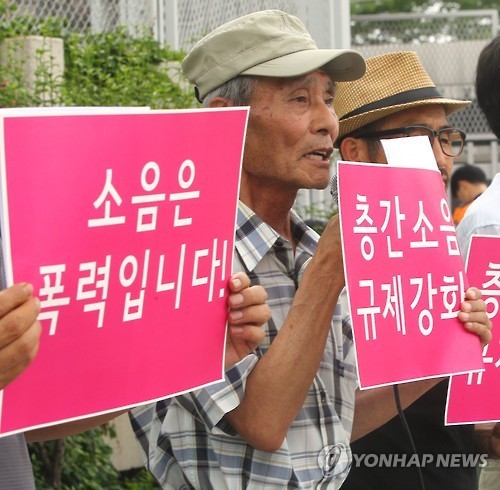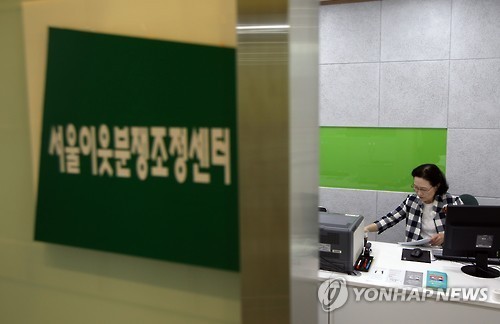[FEATURE] Noise pollution blights city dwellers' lives
By Kim Da-solPublished : Aug. 24, 2016 - 17:10
This is the second installment of a three-part series on Seoul's battle against three types of urban pollution: smell, noise, and light. --Ed.
Bustling with talented young buskers, Seoul’s Daehangno and Hongdae streets turn into vibrant stages at night.
After sunset, diverse buskers flock to the popular areas to show off their skills ranging from rapping, dancing and even putting on magic shows, attracting swarms of passersby.
But for the residents in nearby areas, the artistic outlet is more like a nightmare.
“I want to respect any form of art, but when buskers turn on their amplifiers to maximum volume and start to sing, it just forces me to shut my ears and scowl at them,” said Kim Ju-hyun, 21, a student who lives across from Hongik University.
According to the Mapo-gu Office, the noise levels in areas within a radius of 50 meters of a busking stage at night in Hongdae averages at around 90 decibels. That is about the same level of noise you would experience while using a lawnmower.
Based on the law, noise over 60 decibels after 10 p.m. is considered noise pollution.
Following the growing number of residents’ complaints about noise pollution, the Mapo-gu Office began mandating that buskers’ performances finish by 10 p.m. in July.
The current Noise and Vibration Control Act states that authorities can “control noise and vibration emitted from a workplace, construction field, etc. to maintain a tranquil living environment for residents.”
Bustling with talented young buskers, Seoul’s Daehangno and Hongdae streets turn into vibrant stages at night.
After sunset, diverse buskers flock to the popular areas to show off their skills ranging from rapping, dancing and even putting on magic shows, attracting swarms of passersby.
But for the residents in nearby areas, the artistic outlet is more like a nightmare.
“I want to respect any form of art, but when buskers turn on their amplifiers to maximum volume and start to sing, it just forces me to shut my ears and scowl at them,” said Kim Ju-hyun, 21, a student who lives across from Hongik University.
According to the Mapo-gu Office, the noise levels in areas within a radius of 50 meters of a busking stage at night in Hongdae averages at around 90 decibels. That is about the same level of noise you would experience while using a lawnmower.
Based on the law, noise over 60 decibels after 10 p.m. is considered noise pollution.
Following the growing number of residents’ complaints about noise pollution, the Mapo-gu Office began mandating that buskers’ performances finish by 10 p.m. in July.
The current Noise and Vibration Control Act states that authorities can “control noise and vibration emitted from a workplace, construction field, etc. to maintain a tranquil living environment for residents.”

But the authorities that are responsible for managing noise differ, with varying standards and different regulations, making it difficult for complainants to seek a solution.
The Environment Ministry for instance addresses noise pollution through the Framework Act on Environmental Policy, while the Ministry of Land, Infrastructure and Transport is in charge of controlling noise created from construction sites with its regulations on standards on housing construction.
The number of noise complaints filed with authorities have been rising consistently.
Last year, a total of 41,286 noise pollution complaints were filed with the Seoul Metropolitan Government, an on-year increase of 24 percent.
Another set of Seoul City data collected from 2013 to June this year showed that slightly over 96 percent or 524 cases of civil disputes filed regarding city environment were about noise pollution.
Of them, 347 cases were about noise pollution from construction sites while 95 cases were noise between floors.
The National Environmental Dispute Resolution Commission (NEDRC) under the Environment Ministry received 210 cases last year, of which 84.3 percent pertained to conflicts over noise. Of the noise-related disputes, most concerned construction sites.
Disputes from noise between floors have also been a chronic problem in South Korea.
Half of residents in South Korea live in an apartment complex, according to the Ministry of Land, Infrastructure and Transport. Since Korean apartments are mostly separated by cement walls, sound easily transfers between them.
According to the Korea Environment Corp., the number of complaints over noise in apartments has grown threefold to 15,619 cases in 2015, compared to 7,021 cases in 2012.
To placate these complaints, the government even created a noise complaint reporting center to mediate disputes between neighbors.
In 2012, Korea Environment Corp., which is under the Environment Ministry, launched the National Noise Information System to listen to complaints about noise between floors via phone counseling. The program helped resolve approximately 70 percent of some 75,000 reported cases, as of July.

While some cases of noise pollution between floors are brought to courts, there have been tragic examples of disputes escalating into violence.
Most recently in July, a man in his 30s was arrested for killing a woman who lived upstairs and wounding her husband after months of dispute over noise.
A recent survey by the Anti-Corruption and Civil Rights Commission had shown that 88 percent of South Koreans had experienced noise pollution between floors. Some 36 percent of them were caused by the sounds of children running, 18 percent from the use of electrical equipment such as televisions or washing machines, 16 percent from the sound of adults walking on the floors, 9 percent from musical instruments, and 9 percent from doors shutting.
Experts say that continued exposure to noise pollution can negatively affect physical and mental health.
“Noise pollution can give direct unpleasant feelings to sensory organs and cause symptoms such as headache or heart beating rapidly,” said Bae Myung-jin of professor of voice communication at Soongsil University.
Noise pollution in rural areas, meanwhile, harms animals as well.
Bae, a resident of Jangseong County in South Jeolla Province, has been running a farm raising soft-shelled turtles for two decades before he saw the sudden deaths of over 3,500 turtles last year.
Bae said that turtles’ deaths were caused by noise created as the KTX passed by on a nearby railroad. The railroad was located about 35 meters away from his two water pools containing thousands of turtles.
Korea Rail Network Authority, the operator of the KTX, argued that all its trains are operated under standard noise level requirements -- normally from 45 to 70 decibels at the distance of the turtle pools. They argued they were under no obligation to compensate Bae.
After the case was brought to the NEDRC, the final decision ruled in favor of Bae, ordering the KRNA to pay 70 million won. The NEDRC conducted an experiment that showed that the KTX produced noise at least 30 decibels louder than the standard level.
The Seoul Metropolitan Government vowed to address noise pollution, starting by creating a so-called noise pollution city map. The city aims for a reduction in complaints by 2018.
“We will mark and pay extra attention to noisy areas in the capital to effectively control noise pollution through random on-site inspection or resident counseling program,” said the Seoul Metropolitan Government official from Life Environment department.
“By doing so, we will be able to dramatically view the concentration and source of noise pollution in the capital,” she added.
It also said that it will conduct inspections on some 62 major construction sites and car wash areas in Seoul to check whether they follow the standard noise level requirements.
By Kim Da-sol (ddd@heraldcorp.com)



![[AtoZ into Korean mind] Humor in Korea: Navigating the line between what's funny and not](http://res.heraldm.com/phpwas/restmb_idxmake.php?idx=644&simg=/content/image/2024/04/22/20240422050642_0.jpg&u=)

![[Exclusive] Korean military set to ban iPhones over 'security' concerns](http://res.heraldm.com/phpwas/restmb_idxmake.php?idx=644&simg=/content/image/2024/04/23/20240423050599_0.jpg&u=20240423183955)

![[Herald Interview] Why Toss invited hackers to penetrate its system](http://res.heraldm.com/phpwas/restmb_idxmake.php?idx=644&simg=/content/image/2024/04/22/20240422050569_0.jpg&u=20240422150649)
![[Graphic News] 77% of young Koreans still financially dependent](http://res.heraldm.com/phpwas/restmb_idxmake.php?idx=644&simg=/content/image/2024/04/22/20240422050762_0.gif&u=)







![[Exclusive] Korean military to ban iPhones over security issues](http://res.heraldm.com/phpwas/restmb_idxmake.php?idx=652&simg=/content/image/2024/04/23/20240423050599_0.jpg&u=20240423183955)



![[Today’s K-pop] Ateez confirms US tour details](http://res.heraldm.com/phpwas/restmb_idxmake.php?idx=642&simg=/content/image/2024/04/23/20240423050700_0.jpg&u=)